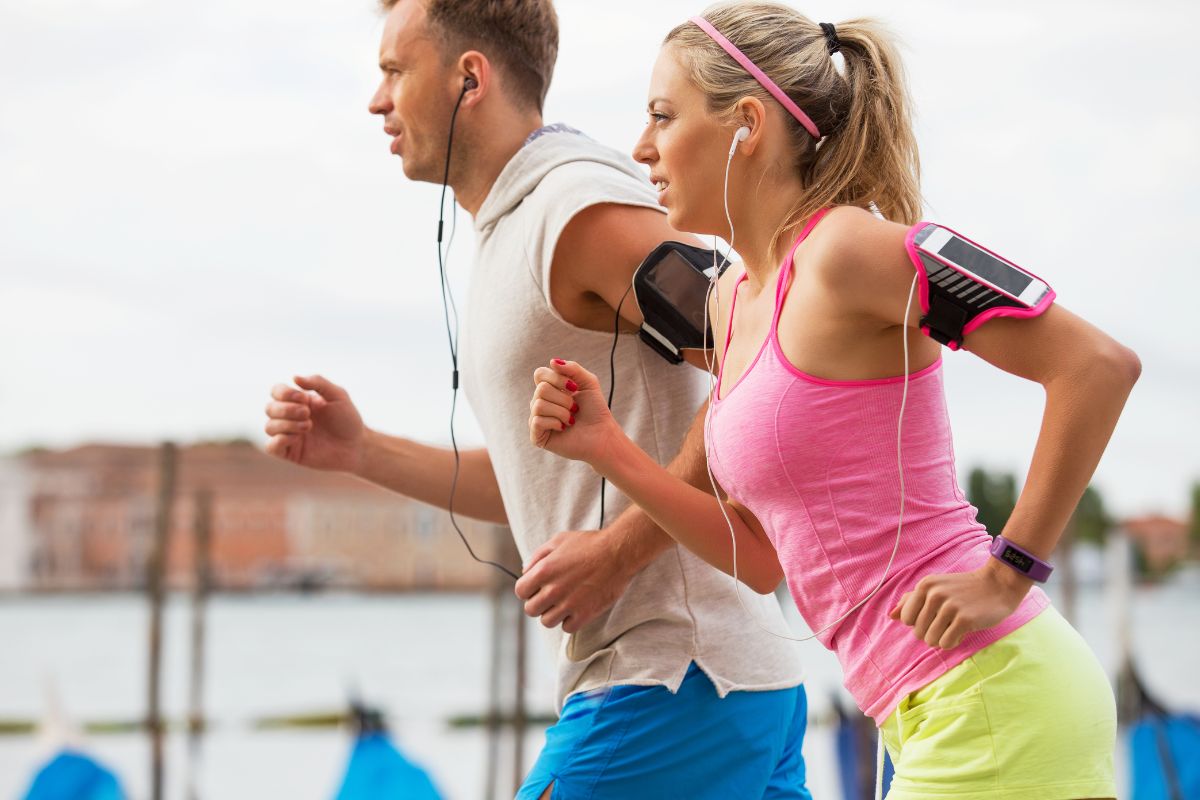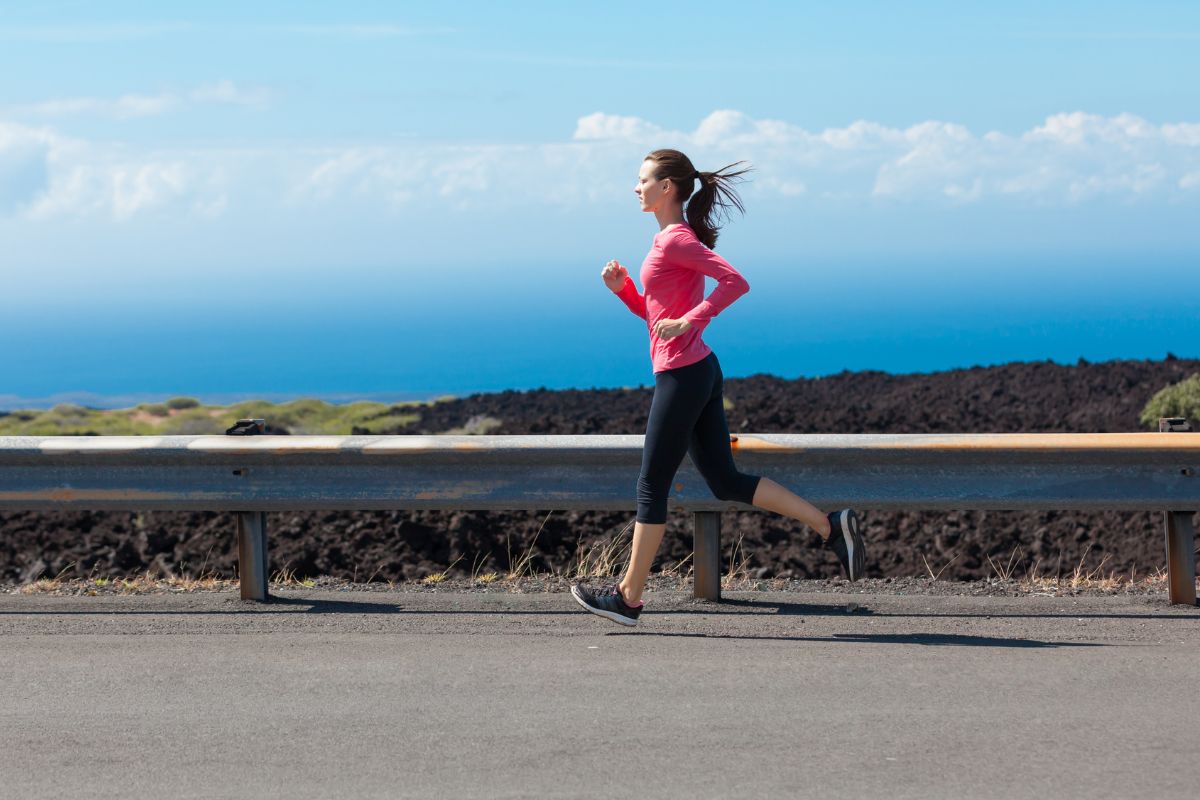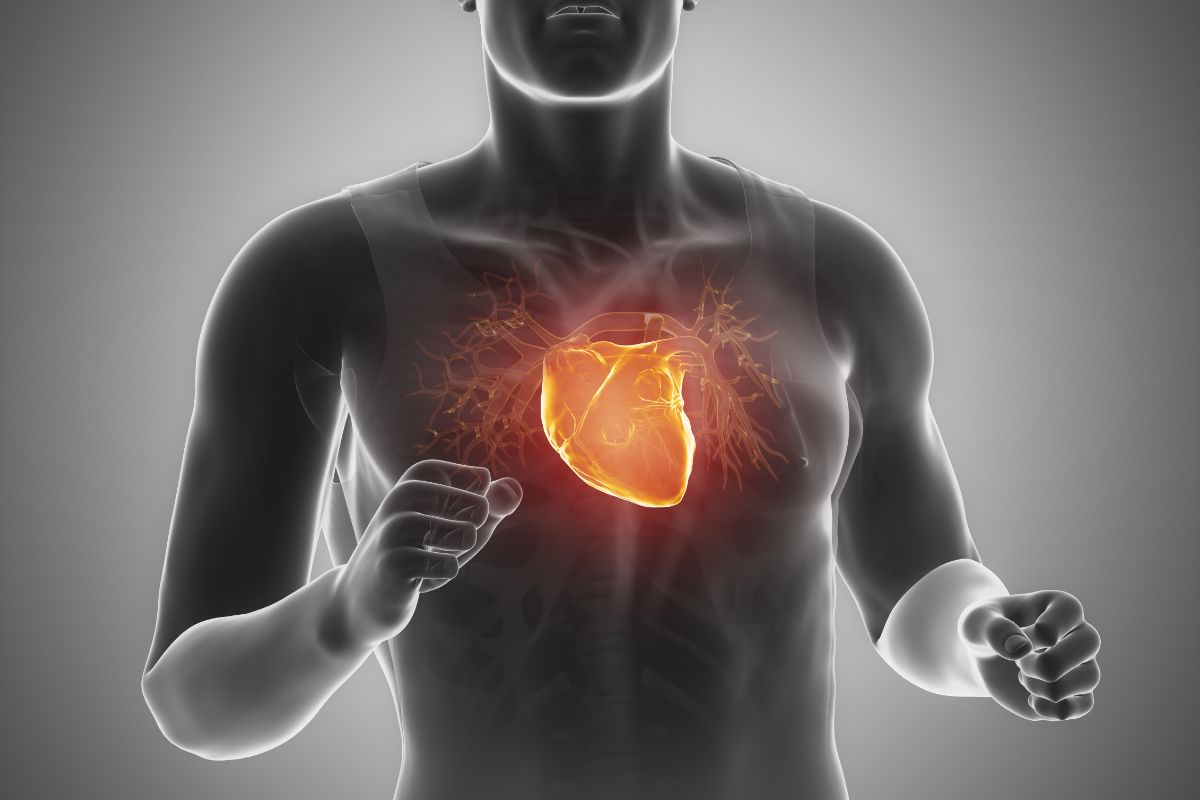If you’re a running enthusiast or a fitness trainer, you may have heard a term called VO2 max. VO2 max values can predict someone’s aerobic fitness level.
Those with lower VO2 max won’t be able to perform as well as others with a higher VO2 max.

This is especially important for those that run medium or high-distance races, as they will be near or at 100% VO2 max.
We’ll cover more about what VO2 max is in this article, including how it’s measured and why it’s so important when running.
You’ll also learn what a good VO2 max value is and the factors that can affect it.
VO2 Max – The Basics
When VO2 max is assessed in a laboratory, it delivers a measurable value of endurance fitness.
These results can be used to compare the effectiveness of training and how well athletes perform during endurance activities.
In the case of athletic performance, maximum oxygen consumption displays endurance and aerobic fitness ability.
Professional athletes, like racing cyclists, long-distance runners, and Olympic skiers, can attain VO2 max values over 80mL/(kg. min).
To put this into perspective, endurance animals, like Alaskan huskies, can achieve VO2 max levels of over 200 mL/(kg. min).
VO2max is measured in milliliters of oxygen per kilo of body weight. It’s calculated using two factors:
- Amount of blood the heart pumps to the muscles with every beat
- How efficiently muscles take in and use oxygen within the blood
Tests That Can Measure VO2 Max
Some fitness coaches and trainers can be certified to deliver VO2 max tests.
However, these tests are usually called ‘submaximal’, as they can’t provide as much detailed information as controlled lab tests can do.
Nevertheless, submaximal exercises are still a good way of measuring VO2 max, as well as total lung and heart endurance capacity during activity. Your fitness level will establish which VO2 max test is best for you.
If you’re a professional athlete or particularly fit, your teacher or doctor might recommend one of these tests:
- 2.4 km run test
- Several stage bleep test
- Astrand treadmill test
If you’re not particularly fit, you can carry out a standard walking/running test on a treadmill. Other VO2 tests you can do are:
- Treadmill test
- Cooper walking/running 1.5 miles test
- Comparing best time or speed results to other results
Can VO2 Max Influence Running Ability?
Oxygen is a very significant factor when it comes to running fast, which is why a greater VO2 max might indicate a better fitness level.
Essentially, the quicker your system can manage oxygen, the quicker you’ll be able to run.
However, while this theory might be true, it doesn’t account for other factors that might affect your performance during a race.
VO2 max might indicate how your aerobic fitness is, but not what you can do with it.
For example, picture two people running at the same pace. One of the runners consumes less oxygen than the other when running.
The person that consumes less oxygen to keep at the same speed uses oxygen more efficiently, which helps them run faster.
However, while their VO2 max might be higher, this doesn’t mean that they’ll run faster on the day.
The faster of the two runners might have a lower VO2 max, but be able to use oxygen for energy better than the other person.
This all depends on how efficiently the runner can use the oxygen they consume. You might have a greater oxygen capacity, but a poor capacity to use it to produce energy.
What Is A Good VO2 Max?
Everyone is different, so there isn’t a single VO2 max value that suits everyone. Your ideal VO2 max depends on your sex and activity level.
For instance, the average VO2 max value for sedentary males ranges between 35 and 40 mL/kg/min. This is slightly more than the average for inactive females, which is 27 to 30 mL/kg/min.
On the other hand, these values increase with greater activity. The average VO2 max for active males is between 42.5 and 46.4 ml/kg/min, but for active females, this is between 33 and 36.9 mL/kg/min.
Remember that these are just averages, so instead of trying to reach a particular number, use these values as a guide to assess your performance.
Factors That Affect VO2 Max
Several factors can affect VO2 max, which includes:
Age
VO2 max decreases 1-2 percent every year after 30.
Training
Regular training helps your body develop its aerobic capacity, which can affect your VO2 max value.
New runners experience the greatest increase in these scores, but these slowly decrease as their training continues.
As you take on more and more training, VO2 will continue to rise, but in smaller and smaller percentages each time.
Sex
Male VO2 max levels are naturally higher compared to women. This is because men have more muscle mass and greater hemoglobin levels, which can all affect VO2 values.
Elevation
Aerobic capacity starts declining at higher elevations as there is less oxygen present in the air. Higher elevations will also affect performance times as athletes cannot take in as much oxygen.
If you are planning on training at a greater altitude, you may want to go over your training plan to account for the elevation changes.
Why Should You Increase Your VO2 Max?
Other than better athletic performance, increasing your VO2 max can help you live a longer life.
A higher VO2 max helps your body transport and use oxygen more efficiently. This helps you keep physically fit and healthy well into your later years.

Other benefits of increasing your VO2 max are:
- Less tired and weary after everyday activities, like climbing stairs or hills
- Reduced stress levels
- Improved immune system, lowering your chances of becoming sick
Increased VO2 Max Benefits
The way the body’s various systems work together in tandem affects VO2 max values, giving us a picture of overall body health.
This reveals how the blood vessels, muscles, heart, nervous system, and lungs work with each other.
Here are some of the main benefits that you may experience when you increase your VO2 max.
Reduced Stress Levels
Exercise is known for its ability to relax the body after a hard day, but an increased fitness level may stop physical stress from occurring to begin with.
There’s a strong relationship between positive emotions and regular physical activity. Those who are more active than others are known to feel less stress and can fight the effects of stress better when they occur.
Completing Everyday Challenges
As your fitness starts improving, you’ll find that living from day to day becomes easier. This can make you feel revitalized as a result.
Whether you’re shopping for groceries, cleaning the house, or heading out for a walk, all physical movement needs energy.
The energy required to carry out activities can be thought of as the amount of oxygen that’s needed to do them, as a VO2 max percentage.
This portion of your maximum aptitude affects how simple or difficult activities feel, and how fast you can finish them.
Increased Performance
As VO2 max determines what your aerobic performance is, it will affect the way you perform when playing sports.
Cardiovascular fitness is important for endurance activities, like cycling and running, but it’s also important in sports like basketball, soccer, and others in which you pant for more oxygen.
Research shows that improving your VO2 max fitness by 5% can improve the time needed to cover a distance of 10k by 5 minutes.
Improved Health
Fitness levels have an impact on your overall health, including your risk of non-contagious conditions.
People who are more physically active have a lower risk of coronary artery disease, cardiovascular disease, type 2 diabetes, and colon cancer.
Researchers from the American College of Sports Medicine also found that improving one’s VO2 max by 10% can lower the risk of all-cause mortality by 15%.
Feeling Young
Getting older can’t be avoided, but keeping active through regular exercise may shield you from aging’s side effects.
The activities that make you fitter can help maintain bone health, aid in weight loss, and support brain health.
Several studies have found that greater VO2 max values have been linked with a reduced risk of Alzheimer’s disease and dementia.
This is also positive news for people who haven’t been active in their younger years, as science shows that you can start receiving the benefits of regular activity at any age.
Can All Runners Benefit From Knowing Their VO2 Max?
VO2 max can be a great way of assessing one’s aerobic capacity, but not all runners have to know their VO2 max activity to become better runners.
If you’ve raced a 5 or 10K recently, you can use your PR to get a rough idea of your VO2 max.
You can make the math a little easier by using online calculators and charts for help. However, you only need to know your VO2 max if your training plan needs it.
After a particular level, VO2 max starts becoming less useful to assess performance. Despite an individual training faster than ever before, people who train often may lose a couple of points.
This indicates that while VO2 max can determine someone’s aerobic fitness level, it isn’t constantly connected with endurance training all the time.
Instead of preparing for an individual, assessed measurement, it’s better to spend the time preparing for your race distance, as well as the requirements to cover it.
Other than that, VO2 max can be a helpful variable when used in scientific research, as it can find and separate training achievements.
Can VO2 Max Help Avoid Heart Disease?
Good cardiovascular health is important to maintain long-term health.
People with a better VO2 max have more chances of living longer, thanks to positive health benefits, including a lower risk of cancer, diabetes, heart disease, and stroke.
The same can’t be said for those with lower VO2 max values.
Research published in JAMA Oncology looked at around 14,000 men for 38 years, attempting to see if aerobic fitness and significant health issues were linked.
They found that people with lower VO2 max values are at greater risk of some types of cancer and heart disease.
These findings aren’t surprising, as most people know that endurance training can prevent particular illnesses and cardiovascular disease.
It also plays a significant part in better mental health.
You don’t need to know your exact VO2 max value to prevent heart disease, but if you’re sitting on the couch most days, increasing your aerobic fitness may help improve your overall long-term health.
How Runners Can Improve Their VO2 Max
Training near or at your body’s VO2 max level is one of the best ways of increasing your VO2 max. Running sessions are a great way of implementing this.
The following running training styles can help you improve your VO2 max:
High-Intensity Training
High-intensity training is the greatest method of increasing your Vo2 max. Most running coaches recommend training at 90% – 95% of your maximum heart rate.
Working out at this high intensity is difficult, but it makes your heart muscles stronger, increasing the amount of blood it’s able to pump around the body with every beat.
You can find your maximum heart rate by subtracting your age from 220.
For instance, if you are 30, subtracting 30 from 220 would give you 190. Your maximum heart rate would be 190 beats per minute (bpm).
Interval Training
Studies have shown that interval training can improve your VO2 max better than continuous cardiovascular training can.
Unlike running at a steady pace for an uninterrupted period, interval training involves small periods of high-intensity exercise, then following these with rest periods.
Here are some examples of interval training you can implement in your plan:
30/30 Intervals
30/30 intervals are a simple, yet effective way of implementing VO2 max training in your plan. They are suitable enough for runners with an average fitness level.
After a decent ten-minute warm-up, 30/30 interval training involves running 30 seconds at high intensity. This will be the fastest speed you can manage for six minutes in a race.
After the 30 seconds are up, you’ll slow down into a light job for another 30 seconds.
You’ll switch between each 30-second interval until you’ve completed a minimum of 12 intervals and a maximum of 20.
This will depend on your fitness level. Every time you finish a 30/30 workout, you can increase the number of intervals you complete.
Once you’ve increased your capacity to finish 20 intervals, you can increase the interval time to 60 seconds.
Perform 60 seconds of the same higher intensity running with 60 seconds of light jogging. Try to work up to as many as 10 intervals, but to start with, aim to finish at least six.
Both 30/30 and 60/60 intervals can be performed anywhere you can run, including tracks, trails, and treadmills.
Hill Incline Intervals
Shorter hill intervals ranging from 20-90 seconds long are great to build strength, speed, and power. However, if you want to improve your VO2 max, longer intervals of 2-3 minutes are better.
Start by finding a hill to perform these intervals on, then warm up for ten minutes beforehand.
Begin by sprinting up the hill for 2-3 minutes, then slowly jog back to your starting position. Depending on your fitness level, repeat these intervals 3-4 times.
If you’re an experienced runner, you can perform as many as 10 intervals, but remember to pace yourself so you don’t tire out early on.
Similarly, you should work hard enough sprinting so that you feel sufficiently tired at the end of the workout.
Lactate Training Intervals
Lactate intervals are the hardest type of VO2 max training. Don’t attempt these if you are a beginner.
It’s best to start with 30/30 and incline training before moving on to lactate intervals.
It’s best to carry lactate intervals out on a track. After a ten-minute warm-up, sprint for 800 to 1200 meters. 800 meters is two laps on a full-scale track, and 1200 meters is three.
Slow down to a light jog for the following 400 meters.
As you begin performing lactate intervals, start with shorter 800 m intervals, then work your way up from there.
For these activities, run a whole cycle of 5000 meters at a quick pace. This would be six to seven 800-meter intervals, five 1000-meter intervals, or four 1200-meter intervals.
Aim to keep at the fastest speed possible for the last stage, even though your body will be telling you to slow down.
VO2 max training is designed to be difficult, which is why most runners only train this way in small amounts.
However, if you want to be better than the majority of runners, spending some time taking on VVO2 max training can make a big difference to your runs.
Challenge Yourself
Once you start attempting to improve your aerobic capacity, practically any type of endurance activity can improve your VO2 max.
However, these gains will start slowing down as you get used to the training.
You’ll need to keep training at greater levels to see improvements.
Increase the frequency of your sessions, your speed through the exercise stages, or the duration of your training periods.
What’s important is that you keep challenging yourself with every workout.
Note Down Your 5K and 10K Times and Pace
If you’re a runner, understanding how fast you can run five and ten kilometers can be useful.
The speed at which you can complete these two levels usually relates to the speed you need to run to achieve 90% to 95% of your maximal heart rate.
Time Needed To Improve VO2 Max
If you’re sedentary, you’ll most likely see an improvement in your aerobic capacity around four weeks after your start training. If you’re fitter, increasing your VO2 max will take more time.
Remember, to keep seeing improvements, you’ll need to make your training more difficult as you go on.
Either increase the distance, intensity, or rate of your training sessions to keep challenging your fitness levels.
Final Thoughts
Your VO2 max assesses the largest amount of oxygen your body can take in when exercising. Training near or at your max heart rate is the best way of improving your VO2 max.
Professional runners who take on endurance challenges usually have very high VO2 max values. Even so, you don’t have to be an athlete to improve your VO2 max!
Working on your fitness levels can help you achieve better cardiovascular health, which has a wealth of positive health benefits to enjoy later on.
- Can Dogs Run Faster Than Humans? (Running With Your Furry Friend) - October 4, 2022
- 10 Doggie Fun Runs You Will Love [Ultimate Guide] - October 4, 2022
- What Are Division Results In Running? - October 4, 2022








